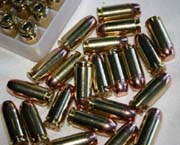| Maryland Newsline |
| Home Page |
Politics
|
Lawmakers Consider Scrapping
Signature Gun Program
By Sarah Abruzzese ANNAPOLIS - Maryland's marquee ballistic fingerprinting program, which has cost the state $2.5 million to date, is imperiled by an unsupportive administration that has called for its end and zeroed out its budget. A few years ago, the program that requires every new weapon sold in Maryland be ballistics tested and filed was heralded as state-of-the-art gun control. President Clinton watched Gov. Parris N. Glendening sign the landmark Responsible Gun Act of 2000 into law. Today, opponents say the system doesn't work due to faulty information, biased technicians and incompatibility with the federal ballistics system. It, they say, should be abolished. Proponents say ballistic fingerprinting offers law enforcement a valuable tool for investigating crime. Delegate Neil F. Quinter, D-Howard, said the program needs to be given more time to fully develop. It is still too early to see if the system that began operating in 2000 is effective, Quinter said, because there is a lag between a gun's purchase and when it is used in a crime -- 3 to 6.1 years. The sponsors said the purpose of the bill to kill the program is housekeeping. With no money in the budget to support the program, said Delegate Joan D. Cadden, D-Anne Arundel, "The program is already dead. ... We need to pass the legislation so State Police won't be breaking the law." The ballistic fingerprinting system cost $1.4 million to set up and State Police estimated it will cost $435,269 in fiscal year 2005. As a legislator, Maryland State Police Superintendent Col. Thomas E. Hutchins voted against Glendening's gun bill, even though he said he supported the ballistics testing component. Now he said the program should be cut. The state's attorney for Prince George's County has a pending murder case in which ballistics fingerprinting helped, but he couldn't reveal details of the ongoing case. "It has the potential to be equivalent to fingerprints and the DNA database," Glenn F. Ivey said. "You have to make sure you can reach a critical mass of data." And there is a significant amount of data that could be put into the system, said a Baltimore City Police Department spokesman. "Just to go by the number of shootings we have in the city," Officer Troy Harris said, "it would be thousands." The state's ballistic database system has 43,729 casings and has had only 208 queries to date. Just six successful identifications have been made -- a reason opponents cite for dropping the program. The state's DNA database, which has assisted in 224 investigations, took as long to bear fruit. Just two years ago it assisted in only 39 cases. That DNA program, which began in 1994 and got its first hit in 1998, does work, said Teresa M. Long, assistant director for the Maryland State Police Forensic Sciences Division. The lag in effectiveness was blamed on federal changes that entailed a complete overhaul of the state's system. Reliability is also a problem, Long said. The state has found 222 test firings conducted by gun makers that were inaccurate, she said. "If you were to investigate other instances you may find them suspect," Long said. Technicians interpreting the data also have biases, she said. That shouldn't be the case, said the vice president for Strategic Planning & Marketing for Forensic Technology, which sold the ballistic fingerprinting system to Maryland. "The system needs to be nurtured," Pete Gagliardi said. "The system needs to be fed. It depends on people. Technology is just a tool. It is only useful if someone uses it." Forensic Technology has supplied 234 systems in the United States, many of them part of National Integrated Ballistics Information Network and New York's system, which also has a ballistic fingerprinting program similar to Maryland's. When he learned Friday of the state's problem with biased information, Gagliardi offered to retrain the users -- for free. Gun advocates see the situation as a vindication of their opposition to the program. "When ballistic fingerprinting was implemented, the NRA said it was a waste of time, money and resources," said Jennifer H. Palmer, the National Rifle Association of America's state liaison. "It doesn't work, it's ineffective." A gun store owner from Baltimore said ballistic fingerprints can easily be changed and that the system only comes up with matches that eliminate guns, not positively identify them. "This is not DNA," Sanford Abrams said. "This is not fingerprinting. Proponents of ballistic testing say Maryland's problem with the system is poor implementation of procedures. The Coalition to Stop Gun Violence wants Maryland to work to connect its system with the federal one so testing could be done statewide. Maryland's system differs from the federal one, which collects ballistic information from crimes. There are simple remedies to the problems the State Police are reporting, said Joshua Horowitz, the coalition's executive director. "These are minor issues you can easily overcome with a well-thought-out work plan," Horowitz said. The Senate Judicial Proceedings Committee, which heard testimony on one bill to eliminate the program March 1, has not set a date for a vote. No vote has been set for the bill in the House Judiciary Committee, which heard testimony Wednesday. Committee members appear divided on whether to scrap the system. "It's confusing," said Delegate Luiz Simmons, D-Montgomery. "Opponents and proponents have their own set of facts." "I think that repealing the bill, if it does not deserve to be repealed," Simmons said, "merely ratifies bad policy and bad administration."
Copyright © 2005 University of Maryland Philip Merrill College of Journalism
|

